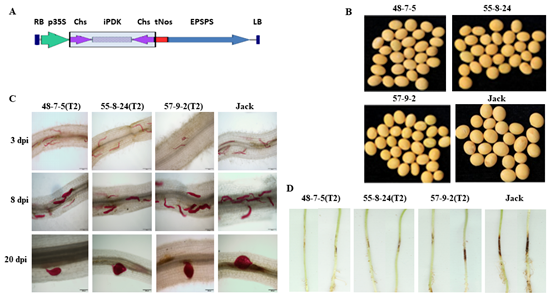IPPCAAS Scientists Developed New Soybean Germplasms Conferring Broad-spectrum Resistance to Both Pathogenic Heterodera glycines and Fusariunm oxysporum
Recently, scientists from the Innovation Team for Monitoring and Control of Crop Nematodes and Bacterial Diseases at Institute of Plant Protection, Chinese Academy of Agricultural Sciences (IPPCAAS) has developed novel soybean germplasms conferring broad-spectrum resistance to pathogenic Heterodera glycines and Fusarium oxysporum by host-induced gene silencing (HIGS), which was published in the Plant Biotechnology Journal.
Soybean cyst nematode (SCN) H. glycines is one of the devastating pathogens in soybean, which causes huge yield losses annually worldwide. Breeding and planting resistance varieties are an effective, economical and environmentally friendly means for management of this pathogen. However, due to the single resistance source of the cultivated varieties, SCN easily overcomes resistance of host soybeans during their long-term interaction. It is desired to breed more and more novel varieties for effective control of SCN H. glycines.
Chitin synthesized by chitin synthase (Chs) is present in nematodes and fungi but absent in plants and vertebrate animals, therefore, Chs is a potential target for designing new fungicides and developing novel resistant varieties by HIGS. Scientists at IPPCAAS first cloned the unique chitin synthase gene in soybean cyst nematode (SCN-CHS) and then constructed a RNAi construct specifically targeting SCN-CHS. The RNAi construct was transformed and induced into wild-type soybean ‘Jack’ to generate the HIGS transgenic soybean lines. Finally, a total of three SCN-CHS HIGS soybean lines carrying this RNAi construct were developed and raised to T6 generation. The T2 and T6 generations of these three HIGS soybean lines all showed significantly enhanced resistance to SCN races 3 and 4 by suppressing development of each stage of SCN, reducing expression level of SCN-CHS in eggs, decreasing cyst size, and diminishing numbers of cysts per plant and eggs per cyst when compared to these from the wild-type Jack, indicating heritability of resistance by HIGS of SCN-CHS. Furthermore, the developed SCN-CHS HIGS soybeans displayed significantly boosted resistance to F. oxysporum, which causes soybean wilt disease. In conclusion, the developed SCN-CHS HIGS transgenic soybeans are the novel germplasms conferring durable broad-spectrum resistance to both H. glycines and F. oxysporum, which are potentially developed into new soybean varieties to control soybean cyst nematode and wilt diseases.
(A) SCN-CHS RNAi construct. (B) SCN-CHS HIGS seeds. (C) Development of SCN in roots of SCN-CHS HIGS soybeans. (D) Fusarium oxysporum-infection phenotype of SCN-CHS HIGS soybeans. ‘48-7-5’, ‘55-8-24’ and ‘57-9-2’ are the developed three SCN-CHS HIGS soybean lines; ‘Jack’ is the wild-type soybean.
More details can be found at the link below:
https://onlinelibrary.wiley.com/doi/epdf/10.1111/pbi.13808
By Liu Shiming (smliuhn@163.com)

-
 Apr 18, 2024Opening Ceremony of the Training Workshop on Wheat Head Scab Resistance Breeding and Pest Control in Africa Held in CAAS
Apr 18, 2024Opening Ceremony of the Training Workshop on Wheat Head Scab Resistance Breeding and Pest Control in Africa Held in CAAS -
 Apr 03, 2024IPPCAAS Co-organized the Training Workshop on Management and Application of Biopesticides in Nepal
Apr 03, 2024IPPCAAS Co-organized the Training Workshop on Management and Application of Biopesticides in Nepal -
 Mar 28, 2024Delegation from the School of Agriculture and Food Science of University College Dublin, Ireland Visit to IAS, CAAS
Mar 28, 2024Delegation from the School of Agriculture and Food Science of University College Dublin, Ireland Visit to IAS, CAAS -
 Mar 25, 2024Director of World Food Prize Foundation visited GSCAAS
Mar 25, 2024Director of World Food Prize Foundation visited GSCAAS -
 Mar 20, 2024Institute of Crop Sciences (ICS) and Syngenta Group Global Seeds Advance Collaborative Research in the Seed Industry
Mar 20, 2024Institute of Crop Sciences (ICS) and Syngenta Group Global Seeds Advance Collaborative Research in the Seed Industry
